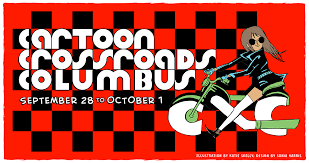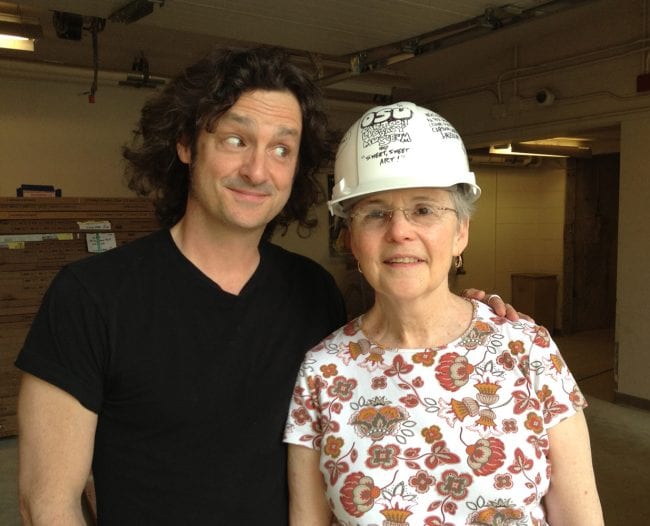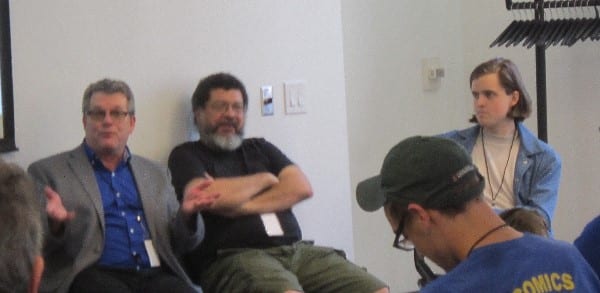I'm part of a small but growing club of people who have staged a comics festival. As such, I'm interested in seeing how new shows develop, especially with regard to what sets them apart from the standard small press model of flea-market floor plus programming. I have no objection to that model at all, but there's an exhaustion factor that emerges when every show is like that; moreover, there's a certain failure of imagination at work when a show fails to consider its host city's unique advantages.
When I was one of the co-organizers of DICE (Durham Indy Comics Expo), for example, one of our principles was that we wanted the artists to have an opportunity to take in as much of the programming as possible. So we had other people take over sales for those who were willing to do so. It also freed the artists up to explore downtown Durham's bars and restaurants if they so desired. And we had a gallery show. With a number of hands-on workshops in a unique venue (a garage turned printing studio), the participants seemed to have a good time.
This gets to the heart of what should make a successful comics show. Whatever local resources are available, make sure to use them. If you have a good local comics scene, make sure to include it. If there are beautiful or unusual venues available, take advantage of them. If there's a local university nearby interested in comics, get their support. If the organizers have ways to incorporate arts other than comics, by all means one should do this. Mixing music, zines, video games, photography, or other arts into the event has been successful for many. Programming should be more than a distraction; it should be carefully considered and the heart of your show. Keep your ambitions low to start, don't look to make money, and consider getting sponsorships and/or crowdfunding to cover your costs instead of passing it on to the artists and attendees.

Cartoon Crossroads Columbus just had its third iteration, and by all accounts it was a success. This show is extremely ambitious in its scope, as founder Jeff Smith, his wife and business partner Vijaya Iyer, and academic/librarian Lucy Shelton Caswell imagined nothing less than an American version of the annual festival in Angouleme, France. The show's mission statement:
"We hope to provide an international showcase for the best of cartoon art in all its forms, including comics, animation, editorial cartoons, newspaper strips, and beyond, in a city that is a growing center of importance to comics and cartooning. We also focus on helping the next generation of young cartooning talent develop thriving careers that invigorate the industry for years to come."
I can't imagine a creator more suited for this particular kind of show than Smith, who sits right in the center of alternative and mainstream comics. His seminal series Bone helped to establish the currently thriving children's and YA market. Caswell is another story, and it's her involvement that gives CXC resources that no other show can match.
When Ohio State alumnus Milton Caniff decided to donate his art, papers, and other ephemera to his alma mater in 1977, the university didn't know what to do with it. So professor and library curator Caswell took over the collection and founded what was to become the biggest repository of cartoon art in the world, the Billy Ireland library. It's absorbed a number of other collections over the years, most notably historian Bill Blackbeard's enormous motherlode of carefully preserved daily strips. (Of note, the library received the collection eighteen years ago, but it's so massive that they've only processed about 40% of it!) In recent years, the collection moved from the basement of the nearby Wexner Center for the Arts into its own beautiful new building.
Now, in establishing the show, Jeff Smith hired writer and critic Tom Spurgeon as Executive Director. Spurgeon possesses a knowledge of and curiosity about the entire breadth of the comics world that makes him an ideal match for the show's mission. For example, Spurgeon has long followed the world of editorial cartooning with great interest (and international editorial cartooning as well), and that has turned out to be an important and popular aspect of the show. Tom also knows everyone in the world of comics, and being plugged-in like that is an enormous advantage.

So the show has the advantage of a sharply-designed mission statement and a director with a clear sense of how to carry that out. The Billy Ireland library was another crucial part of putting the show together. With two full days of programming with no sales, CXC allowed attendees and artists alike to take full advantage of the Library. Behind-the-scenes tours took place every hour on the hour, with a copious amount of holdings (including crazy stuff like animation cels for Winsor McKay's Gertie the Dinosaur cartoon!) laid out as part of the tour. The reading room was open and dozens of incredible pieces of original art were laid out for inspection in a room that also housed an impressive comics library. Upstairs, the galleries included two shows: highlights of the first forty years of the library's collections as well as a more expansive history of comics.

The Friday of this show was packed with enough events to be a highlight of its own. That included multiple panels at the Billy Ireland, including a Leslie Stein watercolor demonstration, and a Signe Wilkinson talk about her career as a political cartoonist. At the nearby Wexner Center auditorium, Billy Ireland curator and assistant professor Caitlin McGurk engaged Chris Ware in a memorable discussion about his career, his new book, and the aesthetics of comics in a packed room. Immediately after that, there was a reception honoring the 40th anniversary of the Billy Ireland library, along with an interesting tradition: the presentation of two of the festival's three awards. The Master Cartoonist award was given to Kyle Baker, and I felt this was emblematic of the festival's overall aesthetic. Baker is somewhere between an alternative cartoonist and a mainstream cartoonist, and further occupies a primary role in another frequently overlooked aspect of comics: humor. The Transformative Work Award was given to Howard Cruse for his classic and influential Stuck Rubber Baby. The fact that this festival not only featured but also honored two cartoonists who came from such different tracks in the history of comics was another way it walked the walk of its mission statement.
The final event of the day was a screening of My Friend Dahmer, based on Derf Backderf's true story of being friends with the serial killer Jeffrey Dahmer in high school. Derf was there to do a Q&A after the film, which proved to be a lively and informative session. The film was interesting in certain key ways it departed from the original story, like removing Derf as the narrator and making the audience privy to scenes that Derf was not, like showing more scenes of Dahmer's home life. Dahmer also revealed the chilling detail that the scenes in the film of Dahmer's house were filmed in Dahmer's actual childhood home. Derf noted that he likes the film, even if he had some differences with the director about certain choices. He also noted that it's a story about failure: the failure of Dahmer's parents, his friends, his teachers, the police, other adults in his life... and ultimately Dahmer himself. The point of the story is to humanize Dahmer but not make the viewer/reader sympathize with him; Derf noted that his sympathy went out the window the moment he heard about the first murder.

If SPX has a sense of being the most comprehensive show in alt-comics with regard to its guest list, then CXC preferred to have a selected smattering, sampling all sorts of corners. For example, SOL-CON, the "brown and black comix expo", was held in conjunction with CXC but was still very much its own entity. They had their own programming track on Thursday and Friday and both shows shared the exhibition floor of the downtown branch of the Columbus Metropolitan Library. There were just over a hundred exhibitors (about 1/6 the size of SPX) on the second floor of this massive building, with panels in three different rooms. Profile panels with Tillie Walden and Emil Ferris drew crowded rooms, as did another political cartooning panel with Wilkinson, Ann Telnaes and Columbus Dispatch local Nate Beeler. My panel, "Indy Creators On Non-Indy Books", featured Peter Bagge, Kyle Baker (this was his first show in years), Jeff Smith and Connor Willumsen. As a moderator, it was perhaps the easiest panel I've ever done. I was familiar with all of their work, so all it took was a question or two to get the likes of some of comics' all-time best talkers to tell ridiculous stories of working for Marvel and DC. Though there were some A/V problems that were eventually resolved, the panel really didn't need it.
The winner of the festival's third award, Emerging Cartoonist, was Kat Fajardo. Fajardo has been making interesting comics for quite some time, so the award and the $7500 cash prize that went with it showed CXC literally putting its money where its mouth is with regard to nurturing young talent. Katie Skelly (who did much of the show's promotional artwork) and Kevin Czap were the previous winners. It's important to note that Fajardo was there as part of SOL-CON, but that CXC considered participants in both shows in giving out the award.
Having attended a number of shows this year, there's a checklist of ideas in my head that I wish all shows would copy from each other. For example, CAKE had gender pronoun preference stickers for free at the registration table--anyone could take one, including attendees. This is a simple gesture that recognizes that these shows are drawing more and more queer fans. CXC has a clearly explained harassment policy; at this point, if you're running a show and don't have one, then you've not thought through the harassment so many — especially, but hardly limited to, women — have experienced at shows like this. Something that MICE does is make ASL interpreting available for all of their programming. Access is another key issue: there were a number of folks in wheelchairs at the show. There were elevators at both the Billy Ireland and the Metropolitan Library, and the tables were spread out enough to allow access. The same was not true for the afterparty sites chosen for the show.
First, I commend the show for having a place for fans and creators to unwind and have fun. On one night, it was a barcade that was on the second floor of a building, and as far as I could tell, there was no other way to access it other than by stairs. The second night was at a bar/theater featuring a performance of David Mack's comic Kabuki done in a multimedia style. The bar was accessible, but it got crowded quickly and I saw one frustrated person in a wheelchair simply turn around instead of trying to go down one aisle. That said, it's a nice gesture for shows to organize get-togethers like this after the day runs down.

The sense I get with CXC is cautious excitement and a desire for slow growth. The scaffolding is there for further expansion. The floor space as it was could have held another 50 to 100 tables, and it was easy to imagine adding another 200 tables on top of that. That vision of a city-wide, week-long festival with many events made use of another city asset: the Columbus Museum of Art, which had a great Laura Park show. This was part of her winning the three-week Columbus Comics Residency, in partnership with yet another show resource, the Columbus College of Art & Design. CCAD's comics program is being run by Laurenn McCubbin and Emi Gennis is one of her first professors, showing just how important comics is to the city. Again, when building a show, one must consider the potential resources and assets that exist on a local level. Having a great local comic shop behind you certainly helps, and the Laughing Ogre is an old, established shop that had a presence at the show, selling alternative comics. The city of Columbus itself, one of the great university towns in the country, is another important resource.
One way I see for the show to expand is to use the same model as the Billy Ireland: combine forces with other groups. The partnership between CXC and SOL-CON seemed to be beneficial for both parties, walking the line between integrating the latter fully within the show without losing its own identity as a show. Finding other such defined groups looking for the occasional home base could similarly expand the show in accordance with its mission. Balancing mainstream, alternative, political, children's and other comics as the show grows will be its #1 concern, as well as ensuring that there's enough of a demand from the public for growth. Sales were reported as solid for most of the people I talked to. Of course, the thing most people liked about the show was its friendliness and laid-back character. Expanding the show while maintaining that atmosphere will be another challenge for the showrunners. Fortunately for them, they have a number of eager allies within Columbus, a strong set of sponsors, and a general degree of goodwill that's unusual for a young show.








